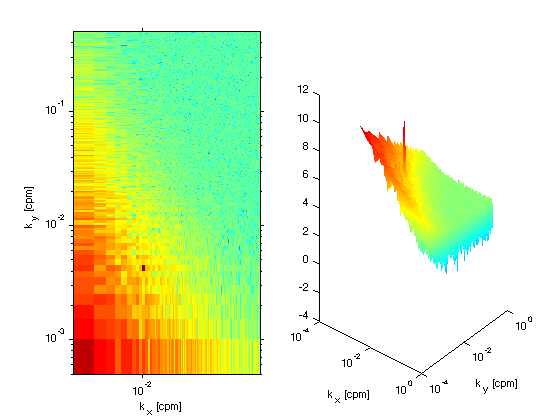Two-dimensional spectral analysis
Contents
Make a synthesized 2-D signal
Here, let  $ and
$ and  $ be the space the data occupies, and
$ be the space the data occupies, and  $ be the signal.
$ be the signal.
xx = 1:1000; yy = 1:2000; [x,y]=meshgrid(xx,yy); kx0 = 0.01; ky0 = 0.004; w = cos(x*2*pi*kx0).*cos(y*2*pi*ky0); figure(1);clf imagesc(xx,yy,w); set(gca,'ydir','no'); xlabel('x [m]'); ylabel('y [m]');
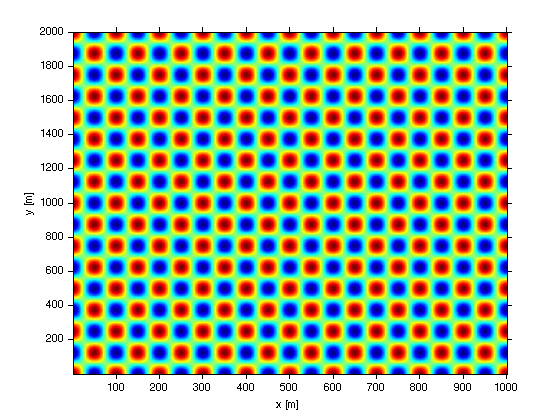
Lets take the powerspectrum in x and look at it...
% first k_x = [0:N-1]/\deltax
M = length(xx);
N = length(yy);
dx = 1;
k_x = (0:M-1)/dx/M;
dy = 1;
k_y = (0:N-1)/dx/N;
X = fft(w')';
Gx = (1/M/dx)*X(:,2:M/2).* conj(X(:,2:M/2));
k_x = k_x(2:M/2);
The spectrum of any individual row is just the spectrum of w at that value of y: For this example, it is just a spike at
 $.
$.
figure(2);clf loglog(k_x,Gx(10,:)) xlabel('k_x [cpm]'); ylabel('G_x(k_x: y=10 m)');
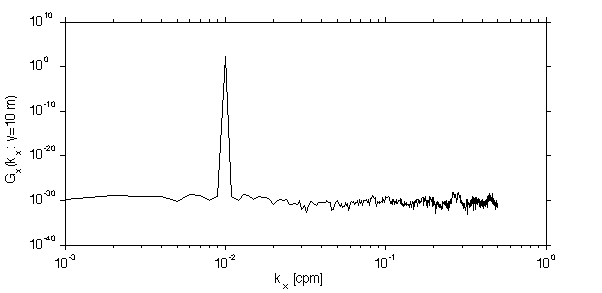
The value of this peak varies with y as  $.
$.
in = find(k_x>kx0); in = in(1)-1; figure(3); clf; plot(y,Gx(:,in)); xlabel('y [m]'); ylabel('G_x(k_x=k_{x0},y)');
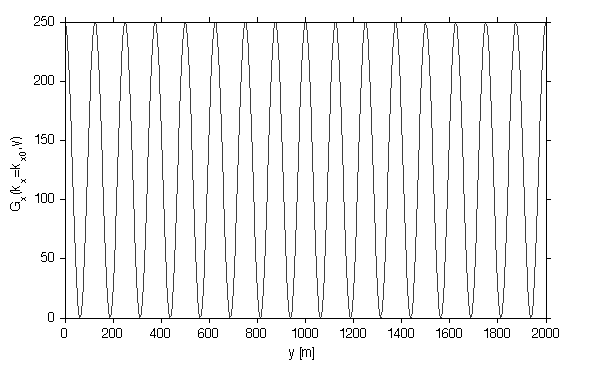
or visualized in 2-D....
figure(4); pcolor(k_x,yy,real(Gx));shading flat; set(gca,'xscale','log'); xlabel('k_x [cpm]'); ylabel('y [m]');
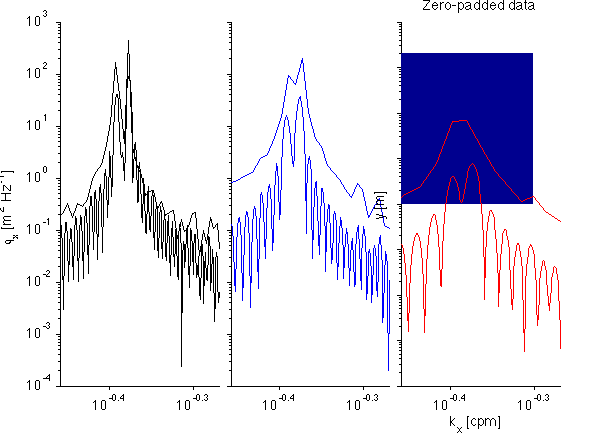
Taking the 2-D Power Spectrum....
XY = fft(fft(w')'); k_x = (0:M-1)/dx/M; k_y = (0:N-1)/dx/N; GXY = (1/M/dx)*(1/N/dy)*XY(2:N/2,2:M/2).* conj(XY(2:N/2,2:M/2)); k_y = k_y(2:N/2); k_x = k_x(2:M/2);
We see the result is a single peak at  $
$
figure(5);clf subplot(1,2,1); pcolor(k_x,k_y,real(GXY));shading flat; set(gca,'xscale','log','yscale','log') xlabel('k_x [cpm]'); ylabel('k_y [cpm]'); subplot(1,2,2); surface(k_x,k_y,real(GXY));shading interp; set(gca,'xscale','log','yscale','log') xlabel('k_x [cpm]'); ylabel('k_y [cpm]'); view(30,30); w0 = w;
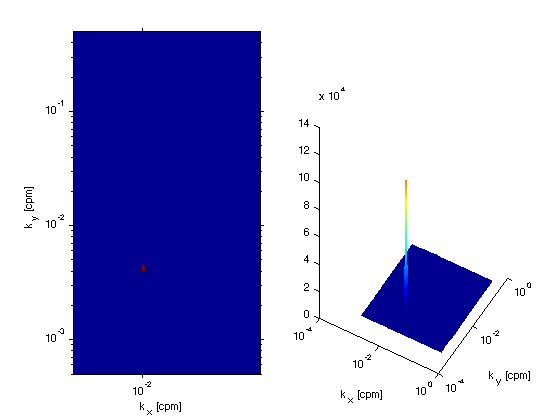
A more interesting process.
Consider a 2-D white noise process, and then integrate separately in both x and y to get red processes in both dimensions.. Then ad the noise back on...
wp = randn(N,M); w = cumsum(cumsum(wp)')'; w = w+wp*50+1000*w0; figure(10);clf subplot(2,1,1); imagesc(xx,yy,wp); set(gca,'ydir','nor'); title('w'''); ylabel('y [m]'); subplot(2,1,2); imagesc(xx,yy,w); title('w'); set(gca,'ydir','nor'); xlabel('x [m]');

Do the 2-D spectral estimate...
XY = fft(fft(w')'); k_x = (0:M-1)/dx/M; k_y = (0:N-1)/dx/N; GXY = (1/M/dx)*(1/N/dy)*XY(2:N/2,2:M/2).* conj(XY(2:N/2,2:M/2)); k_y = k_y(2:N/2); k_x = k_x(2:M/2);
Note how the spectrum has large amlitude at low wavenumbers, and then hits a noise floor at high wavenumbers.
figure(15);clf subplot(1,2,1); pcolor(k_x,k_y,log10(real(GXY)));shading flat; set(gca,'xscale','log','yscale','log') xlabel('k_x [cpm]'); ylabel('k_y [cpm]'); subplot(1,2,2); surface(k_x,k_y,log10(real(GXY)));shading interp; set(gca,'xscale','log','yscale','log') xlabel('k_x [cpm]'); ylabel('k_y [cpm]'); view(40,20);
